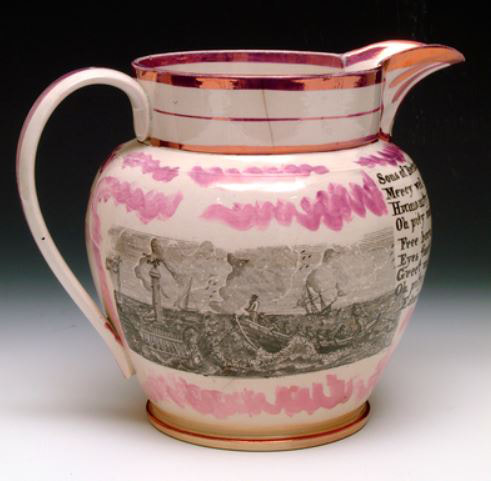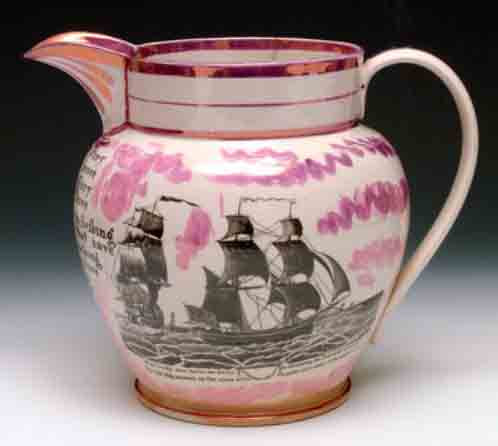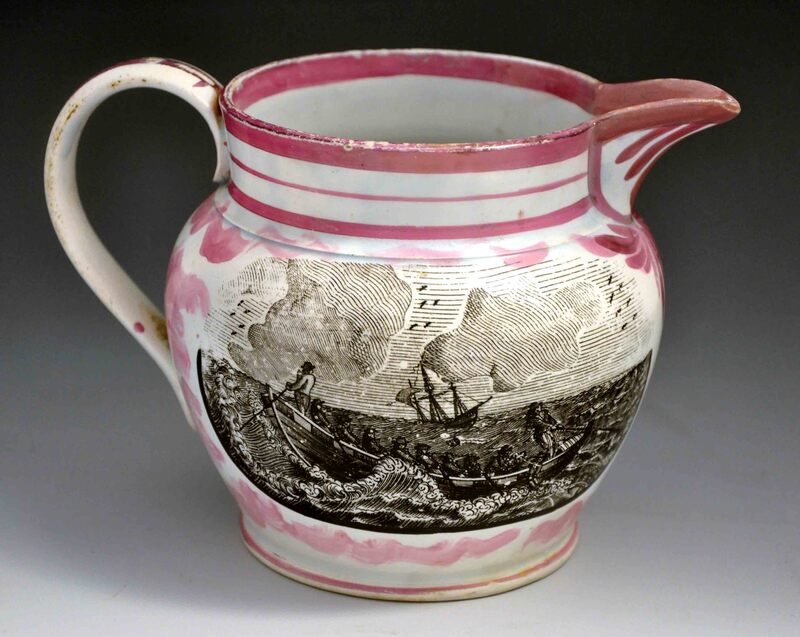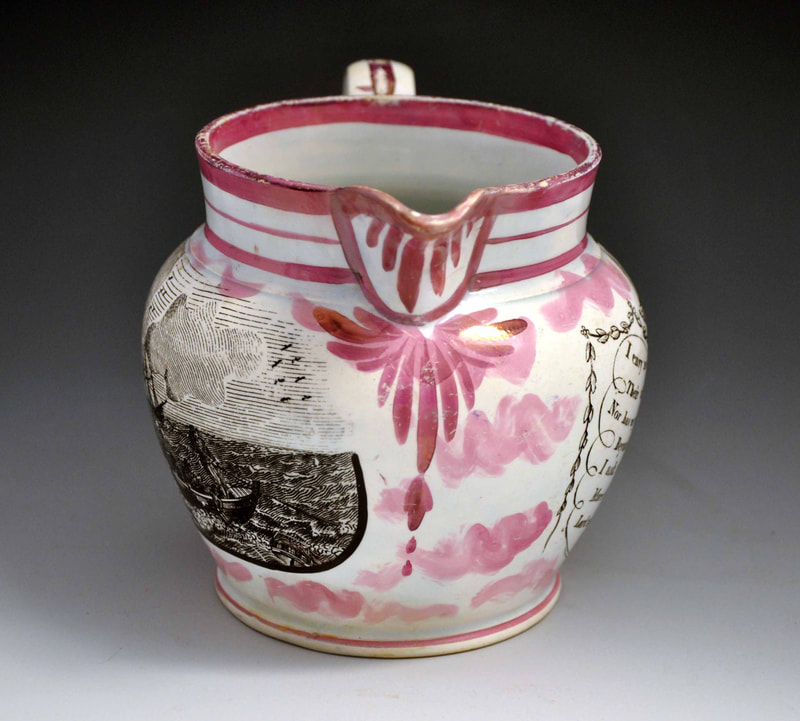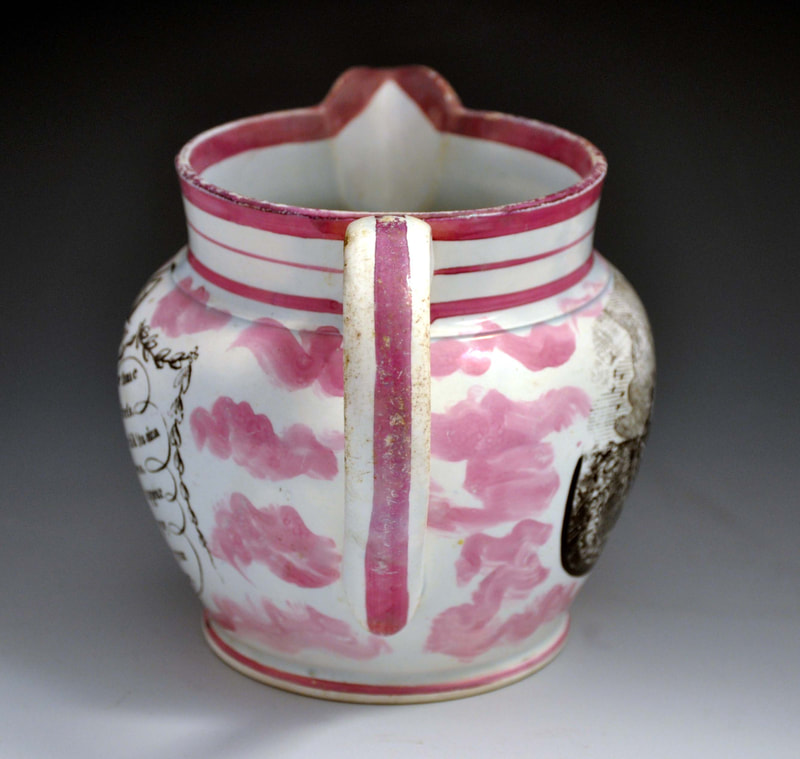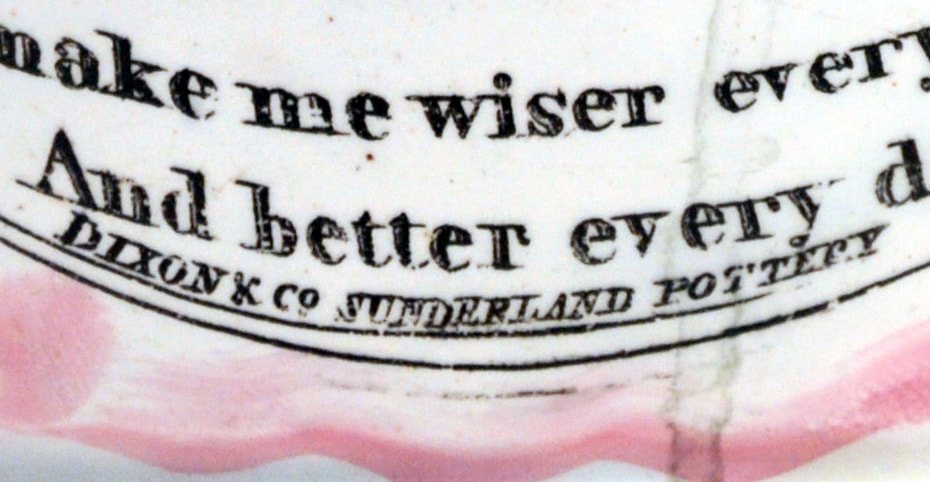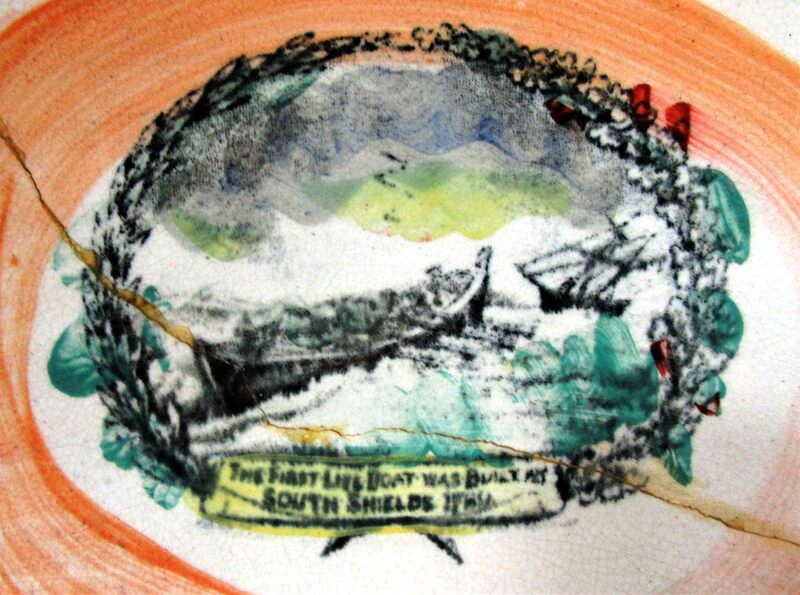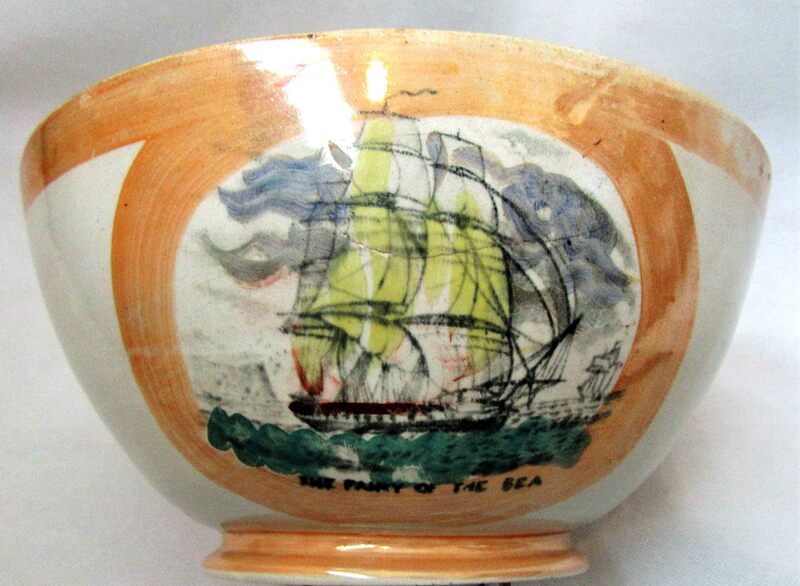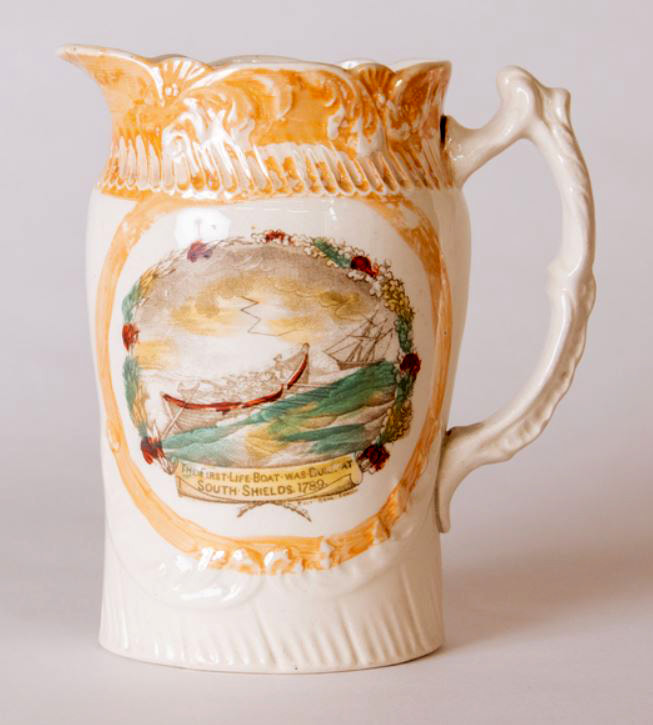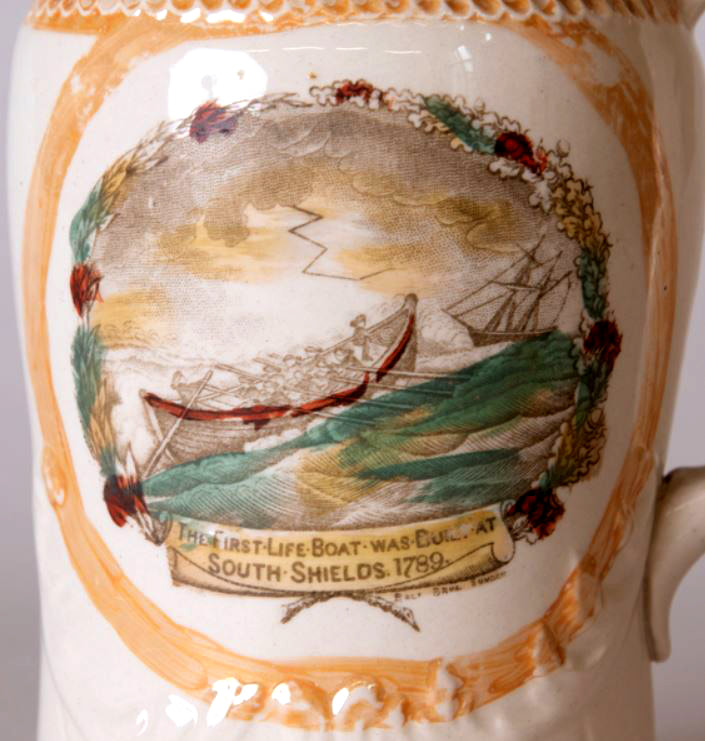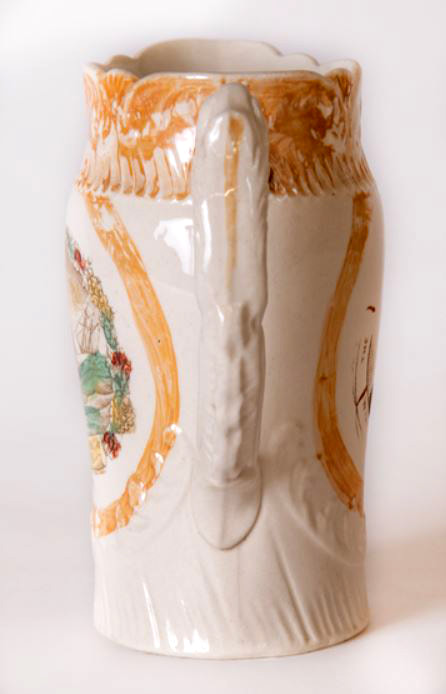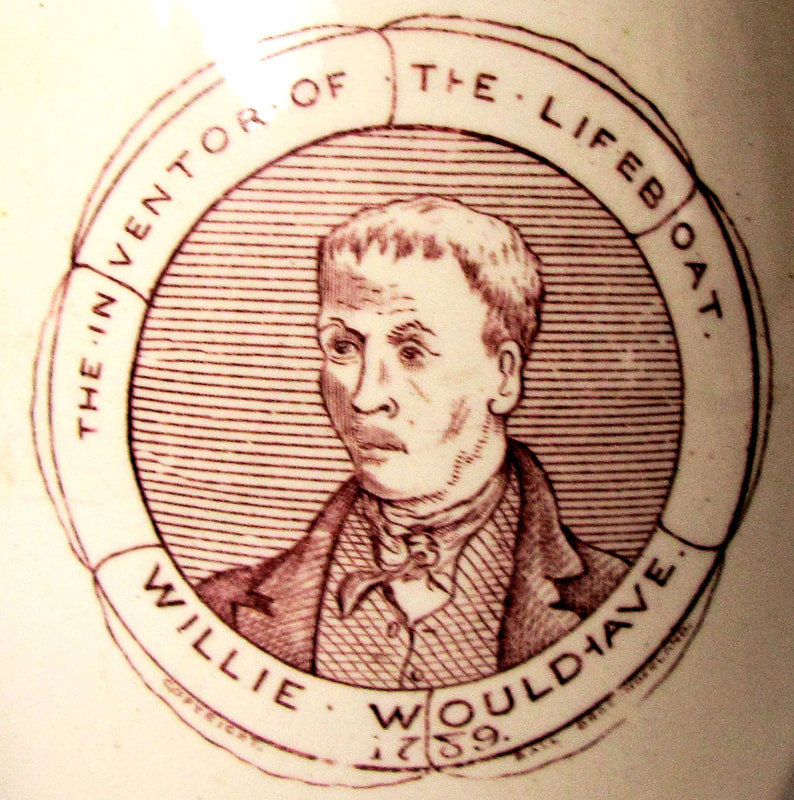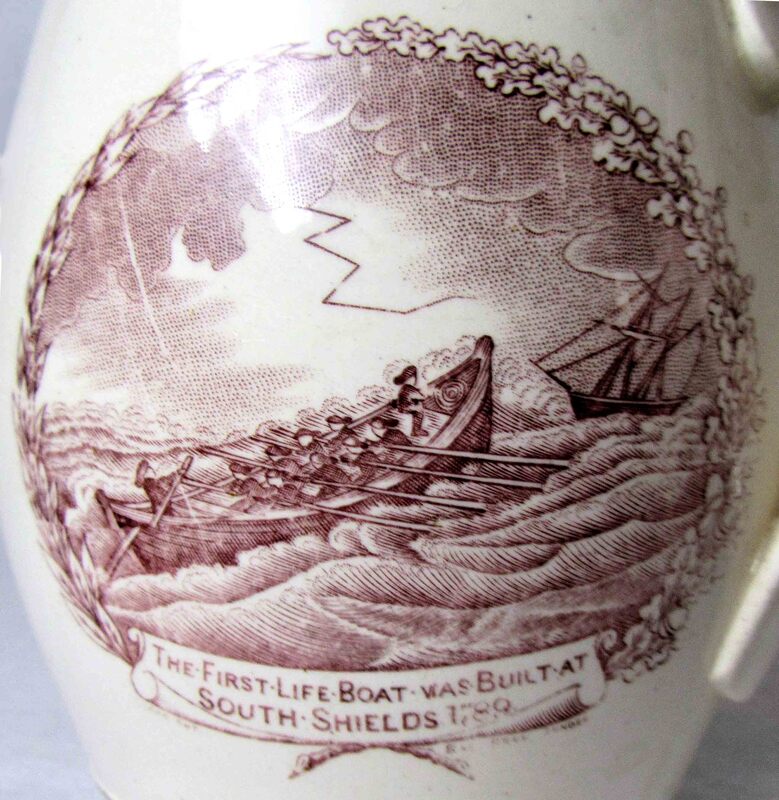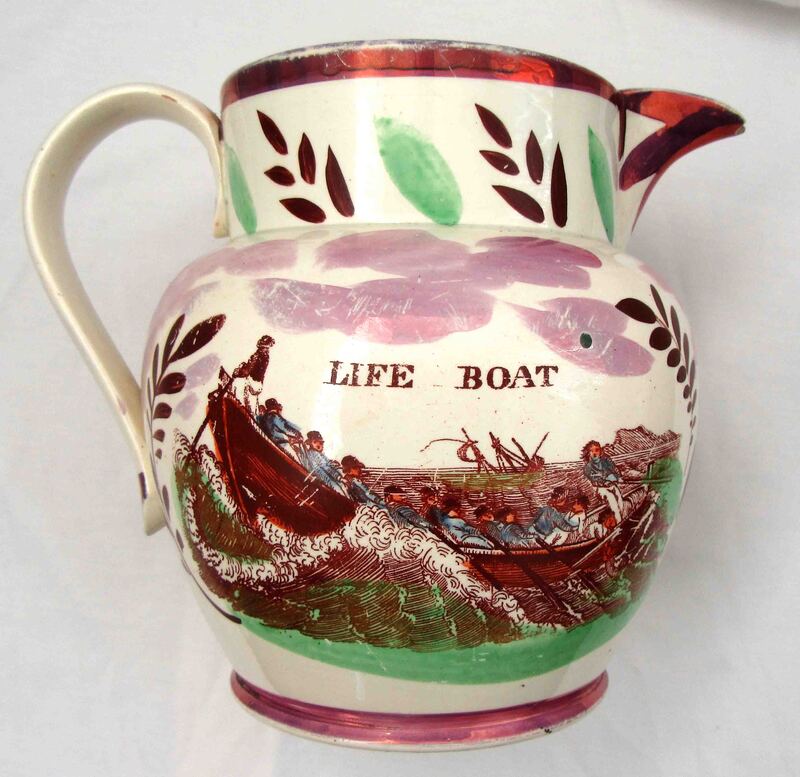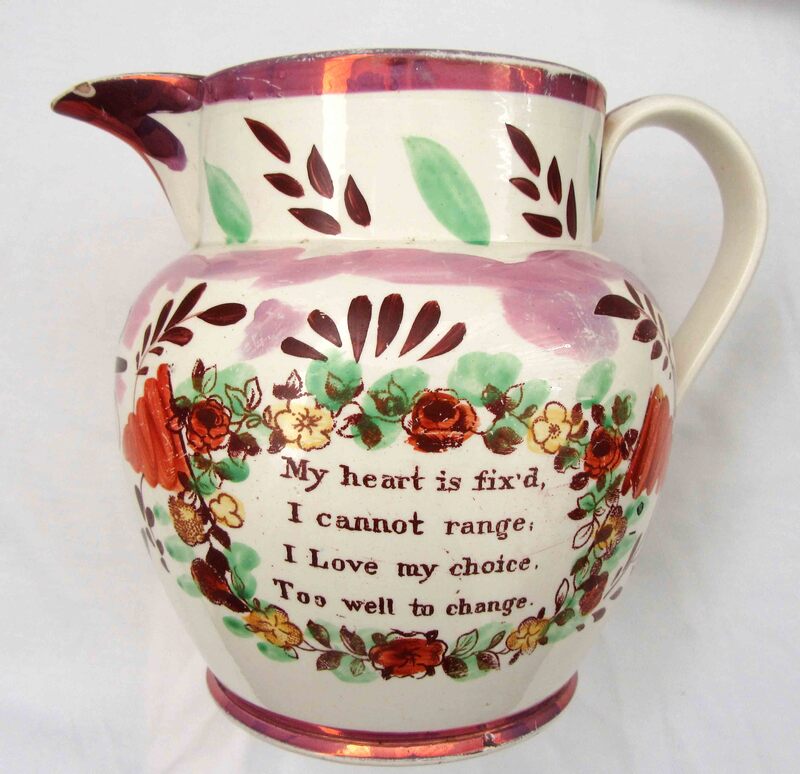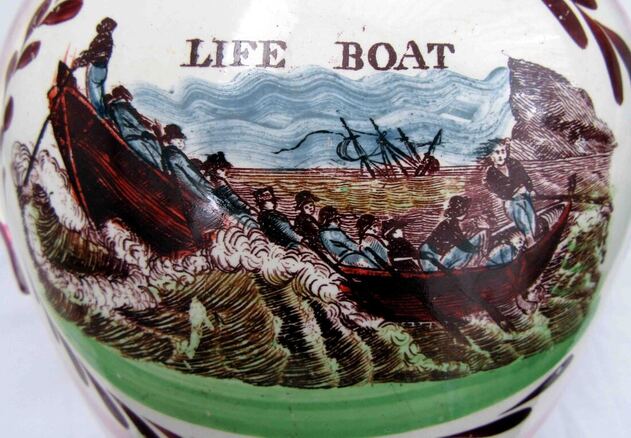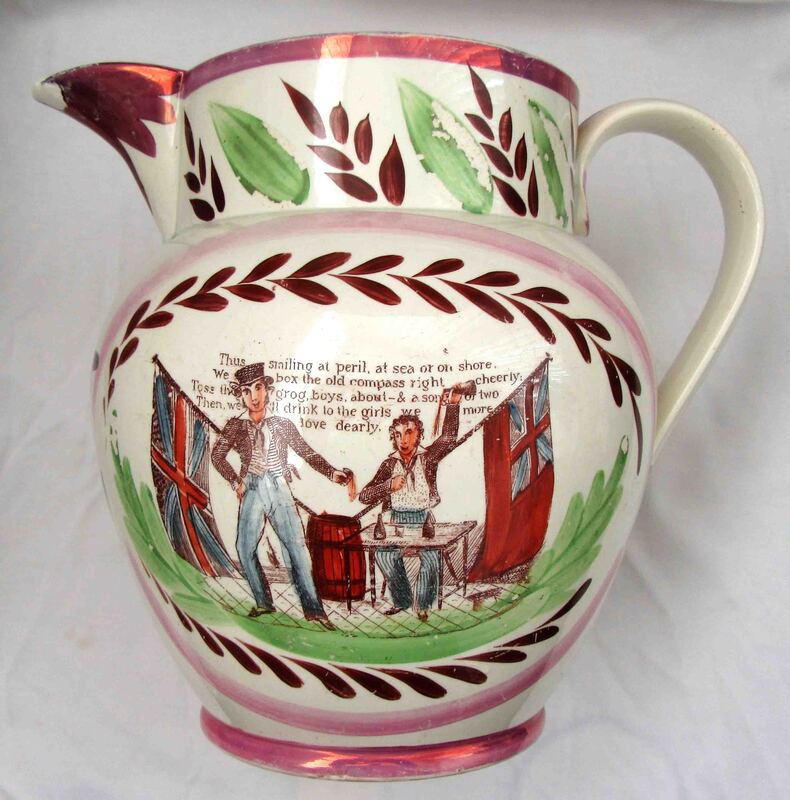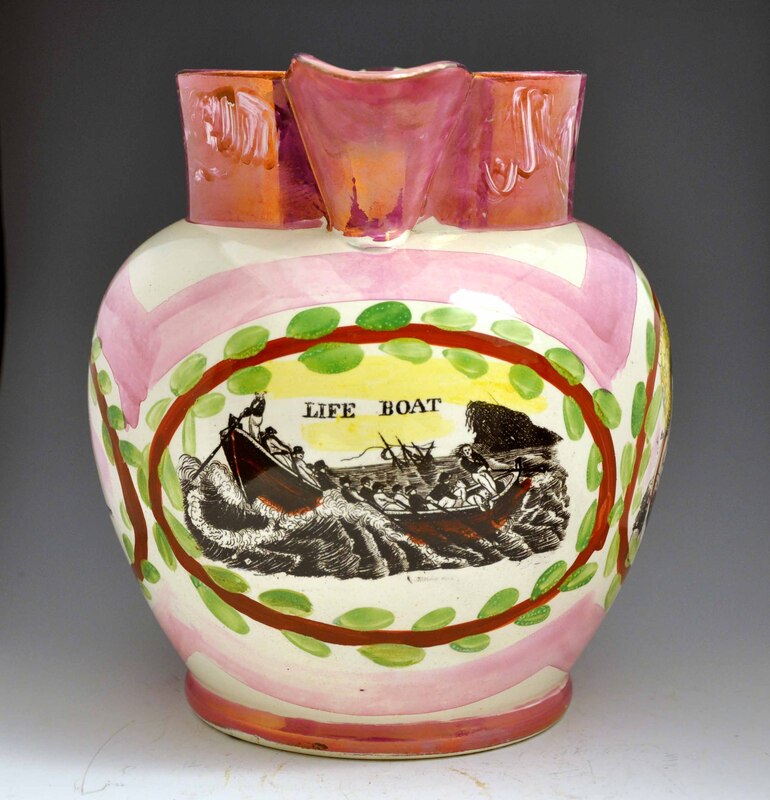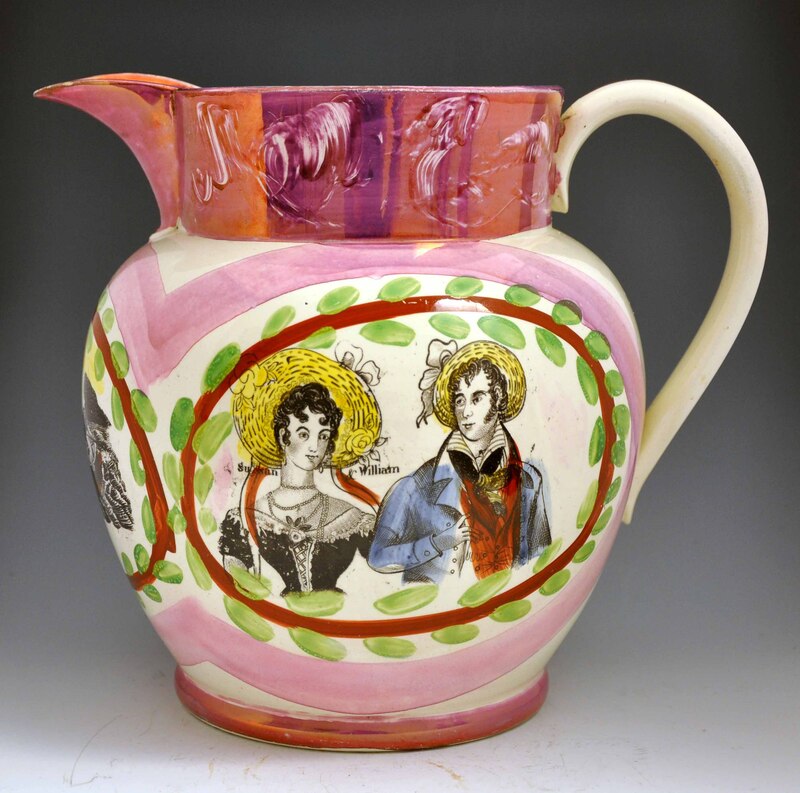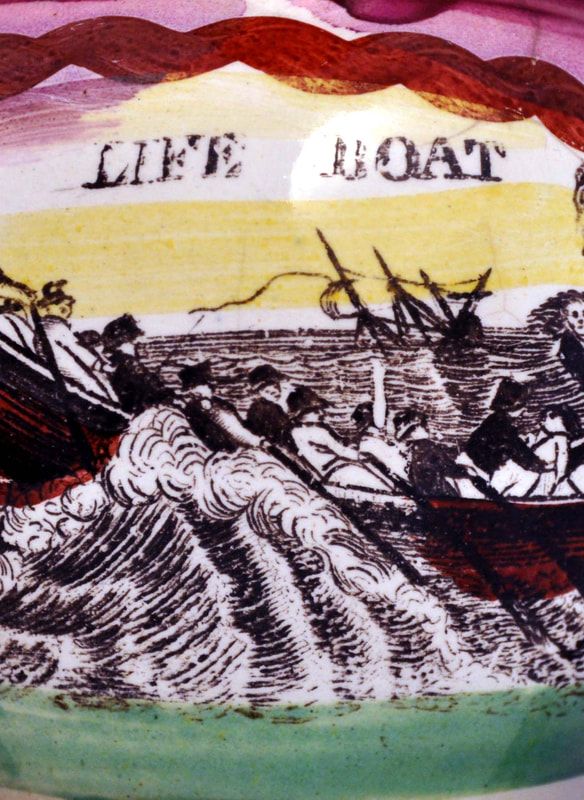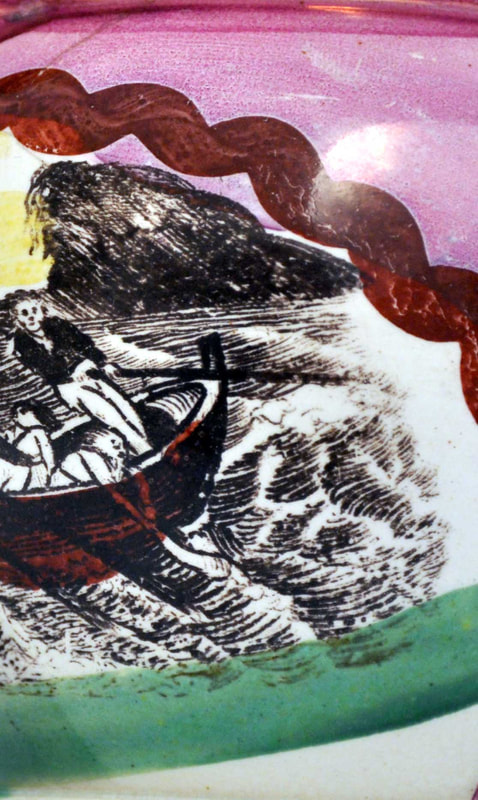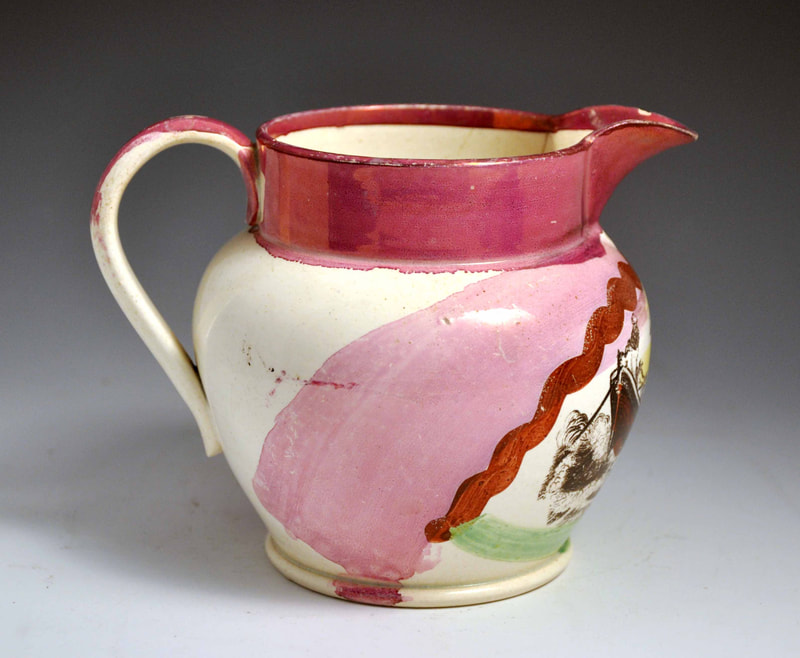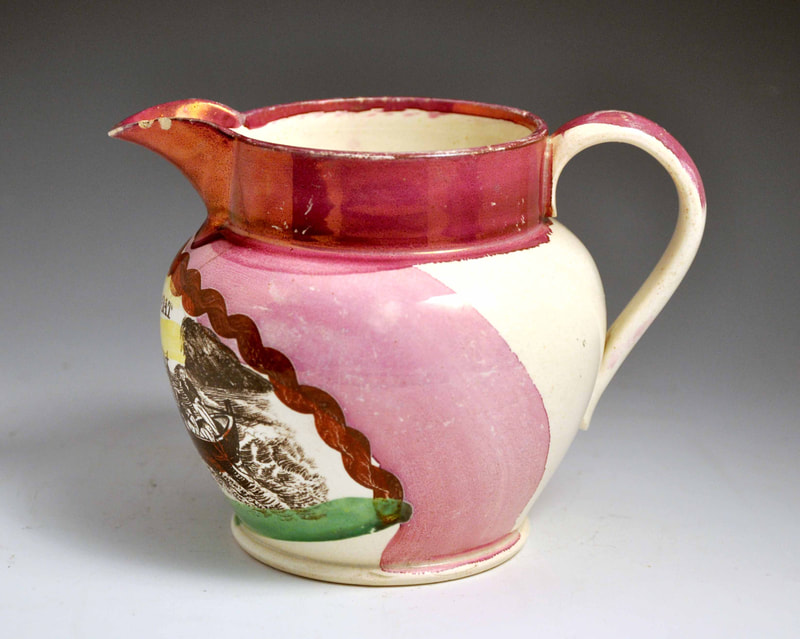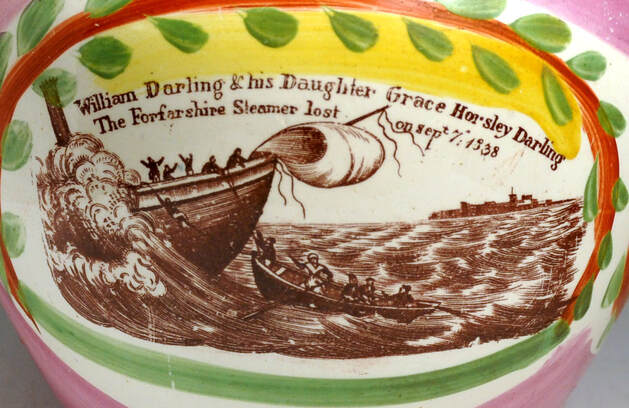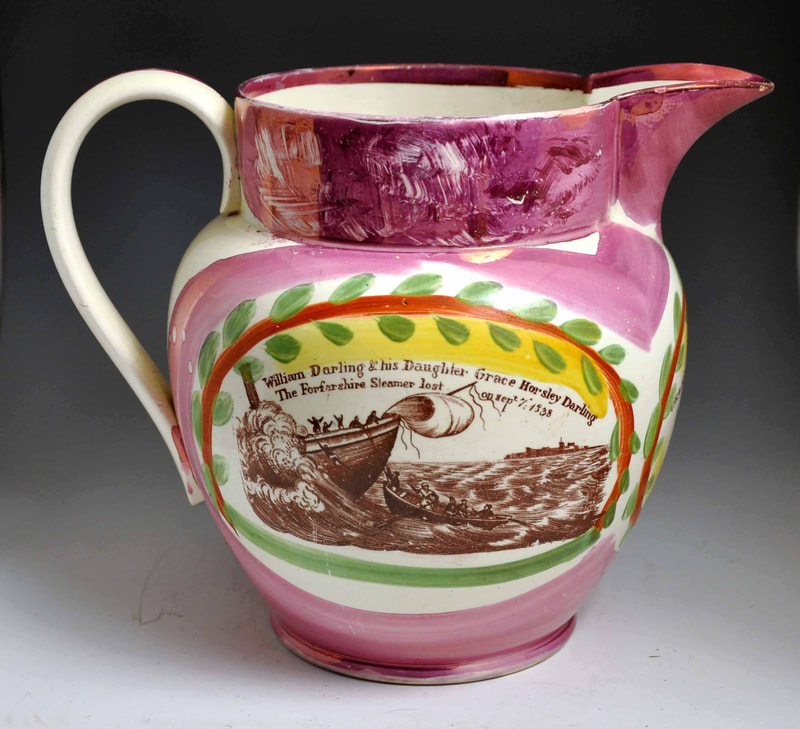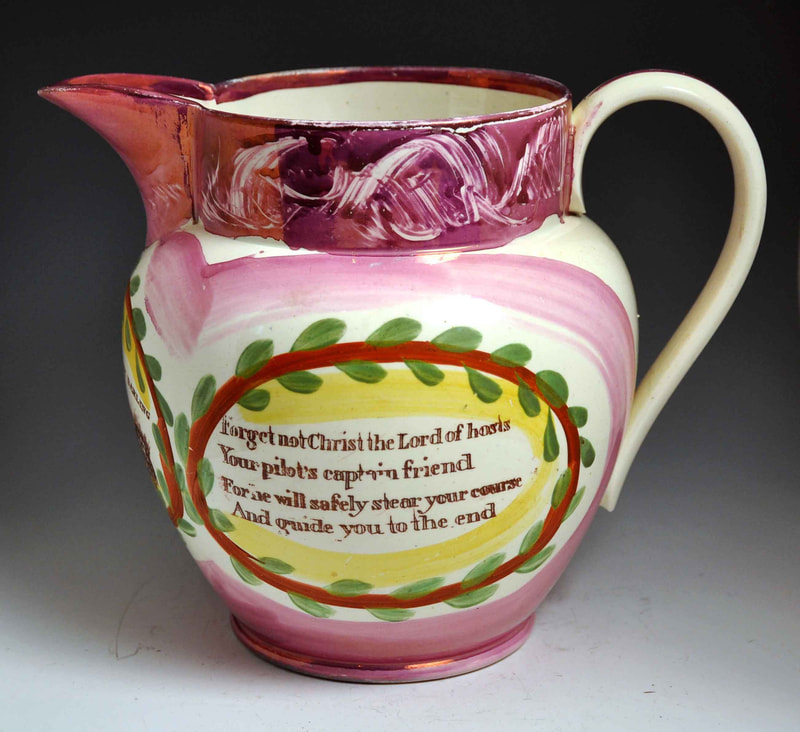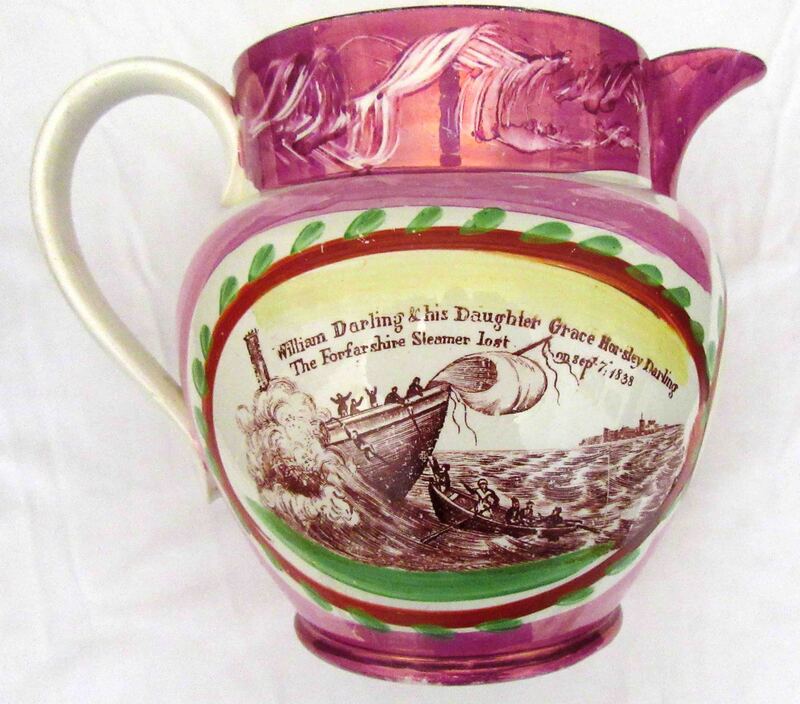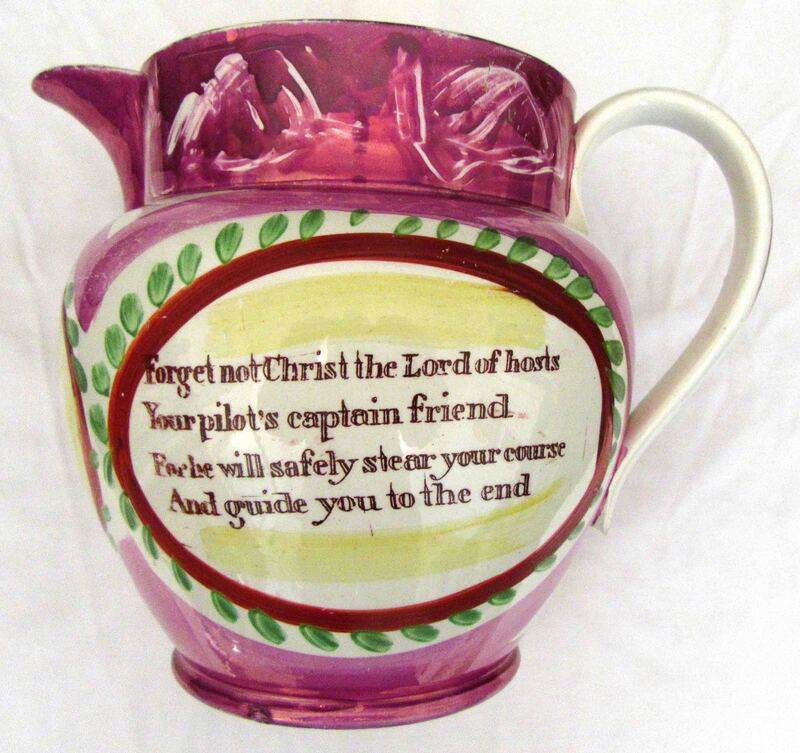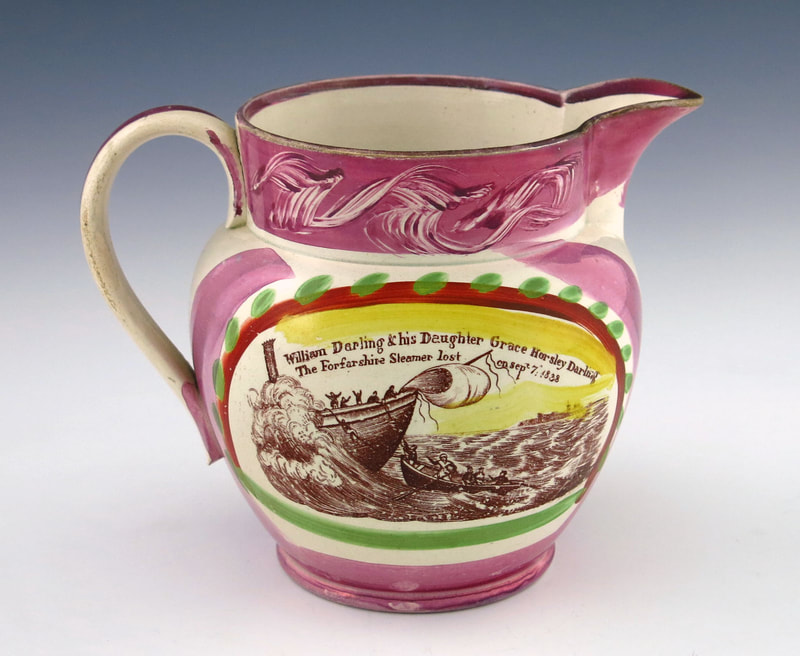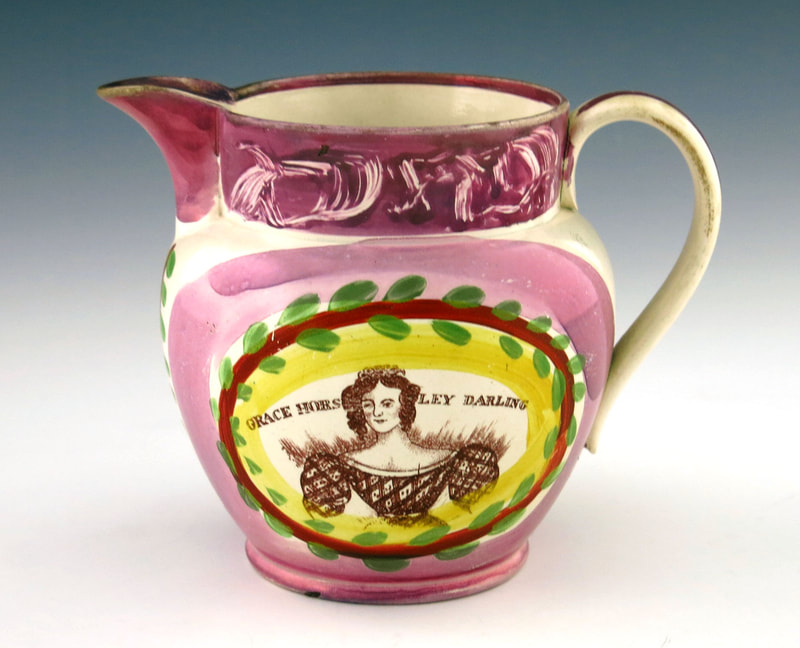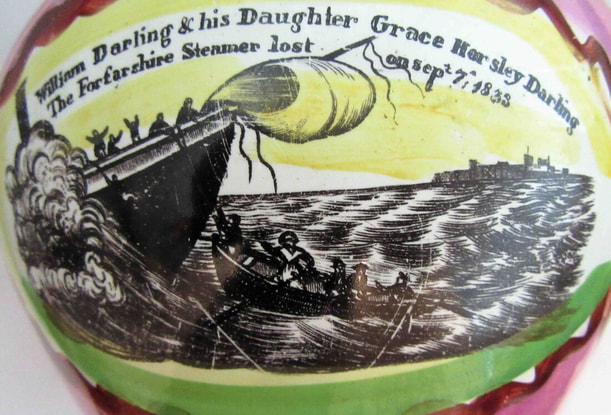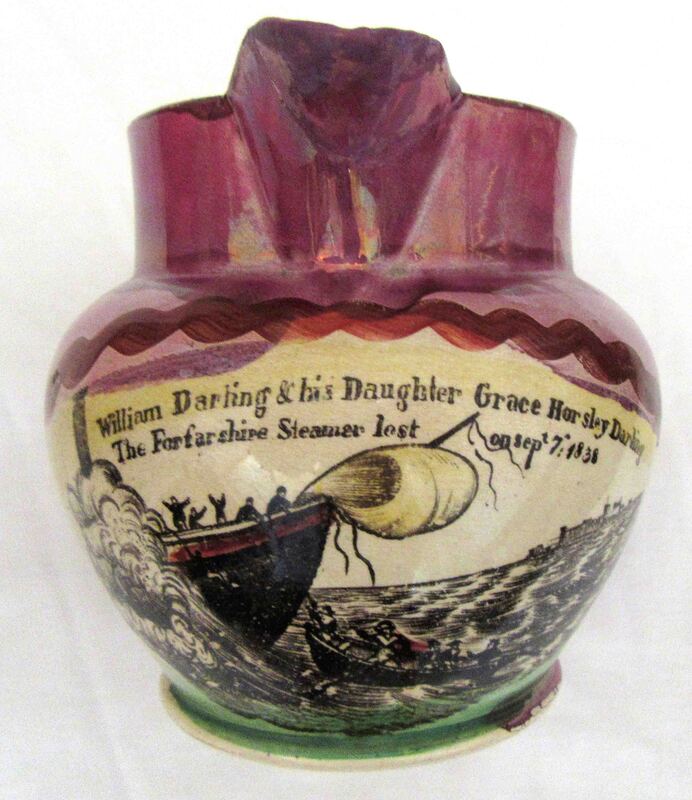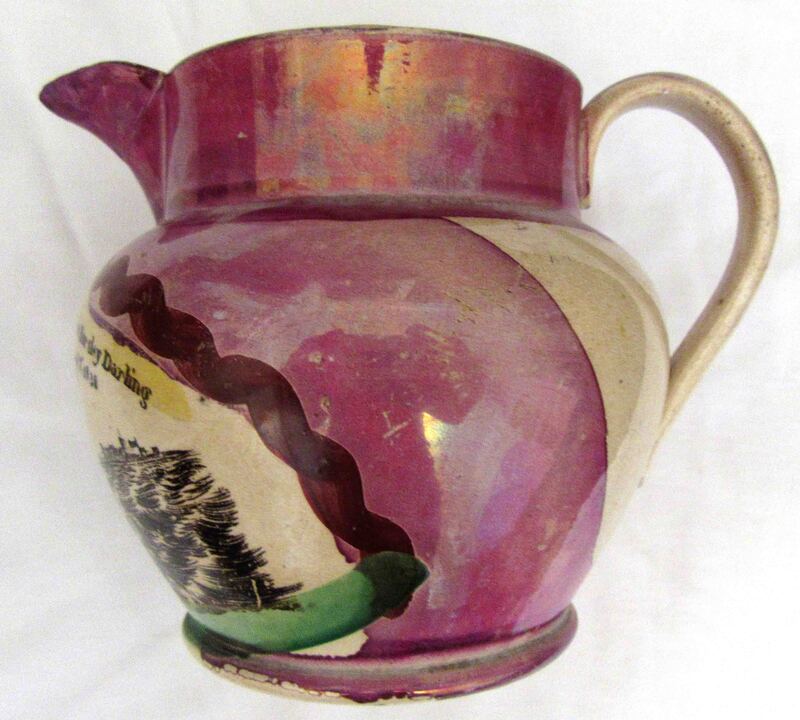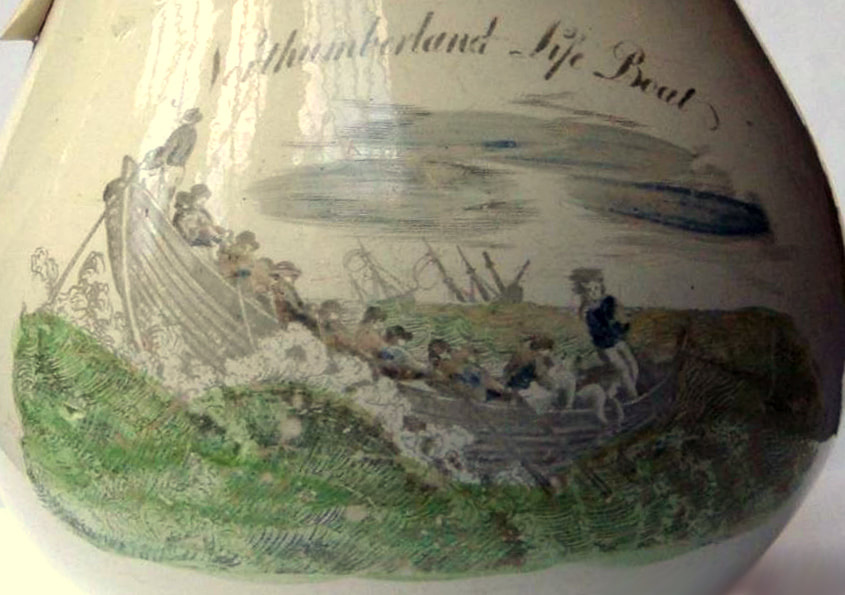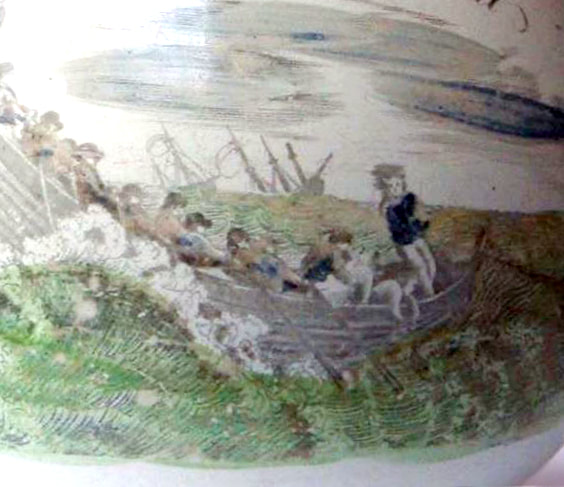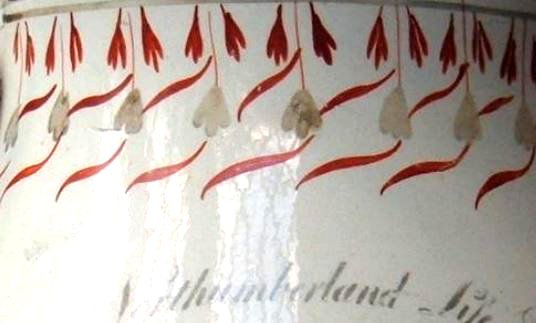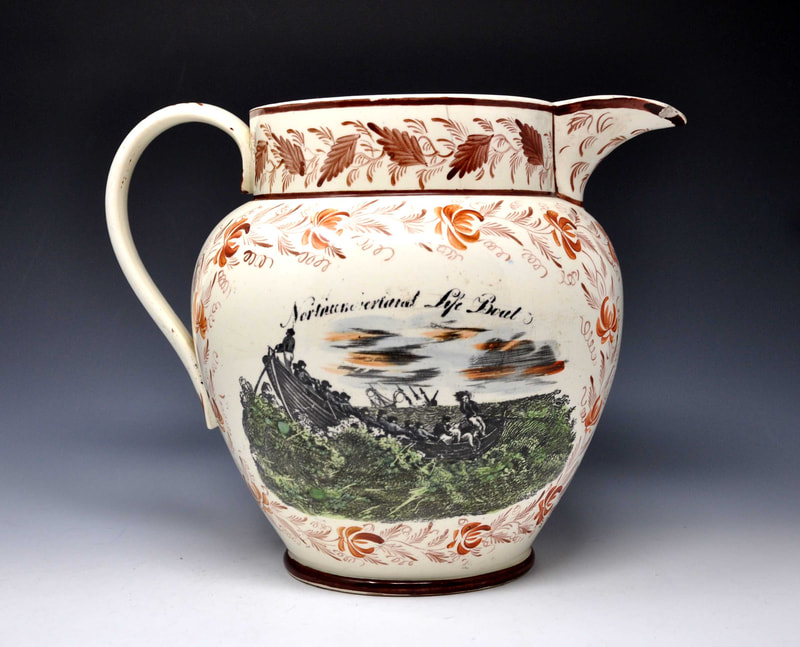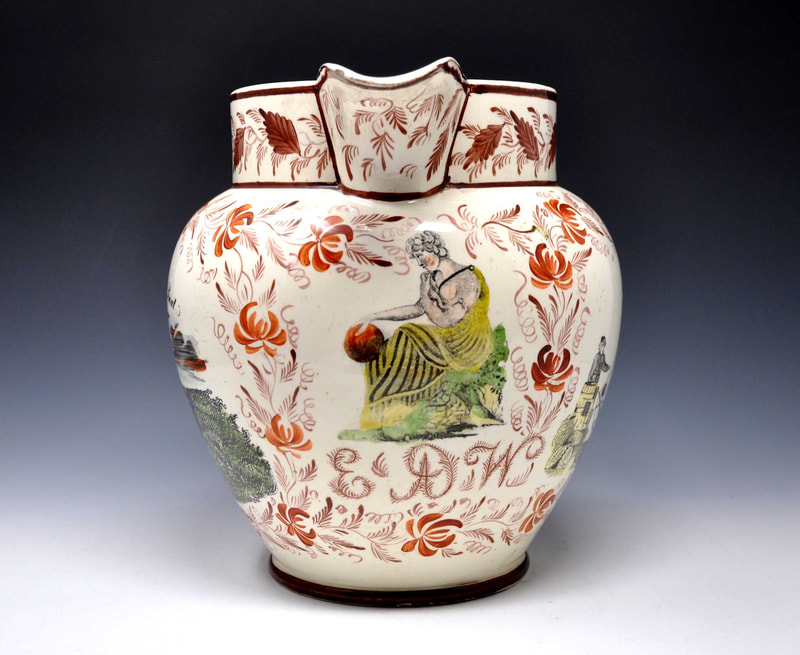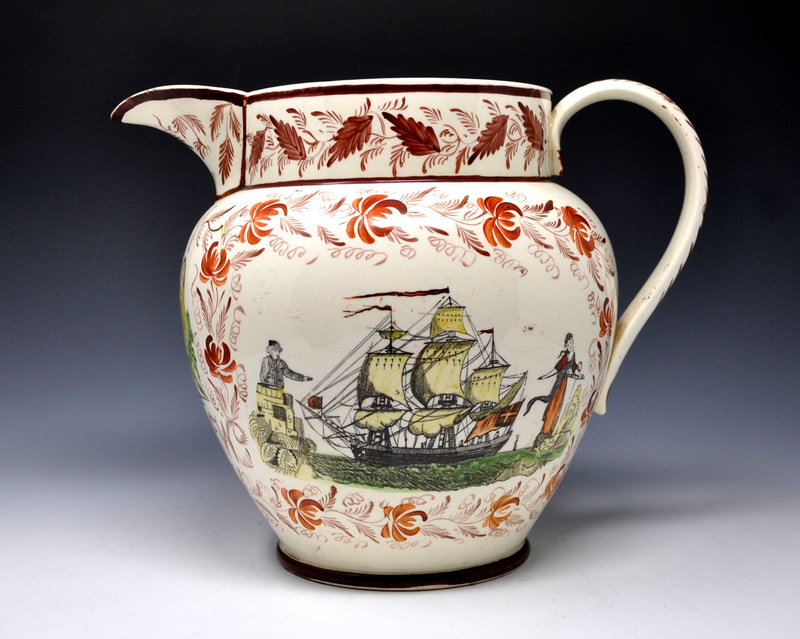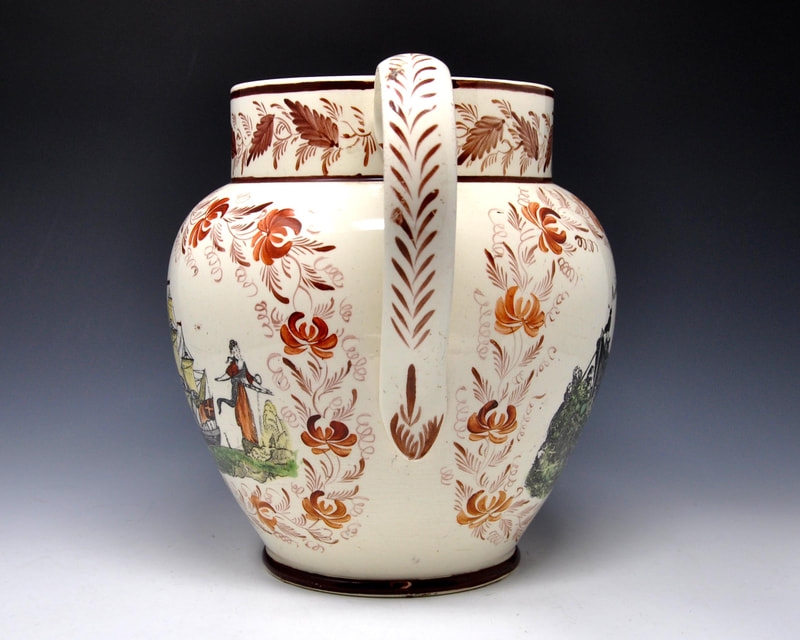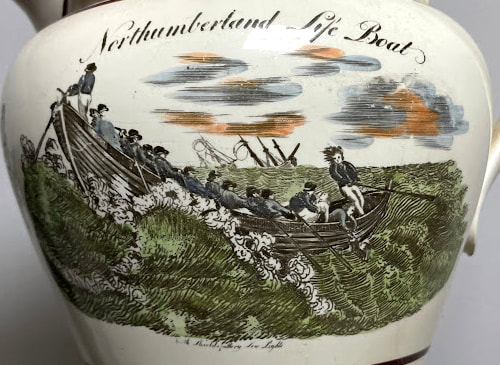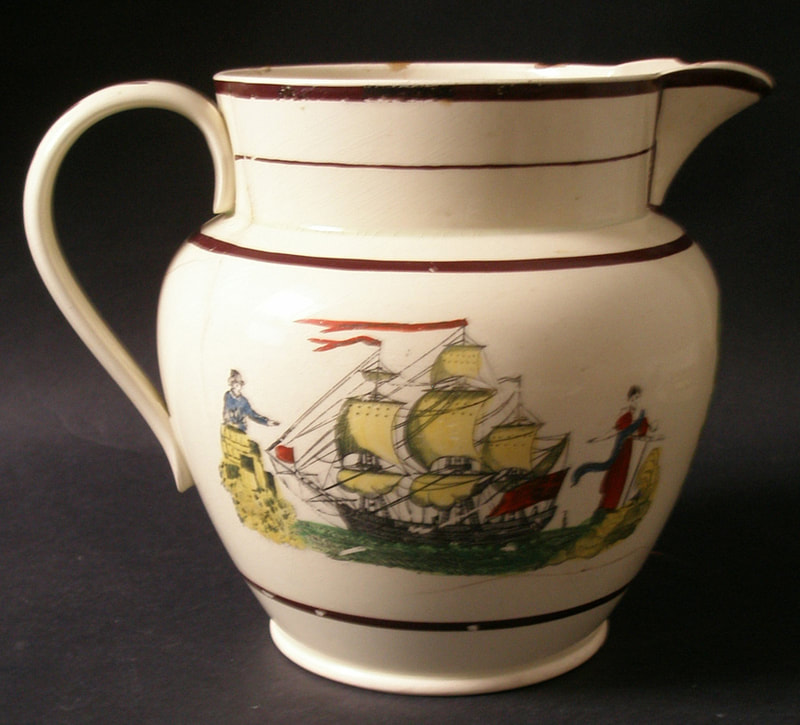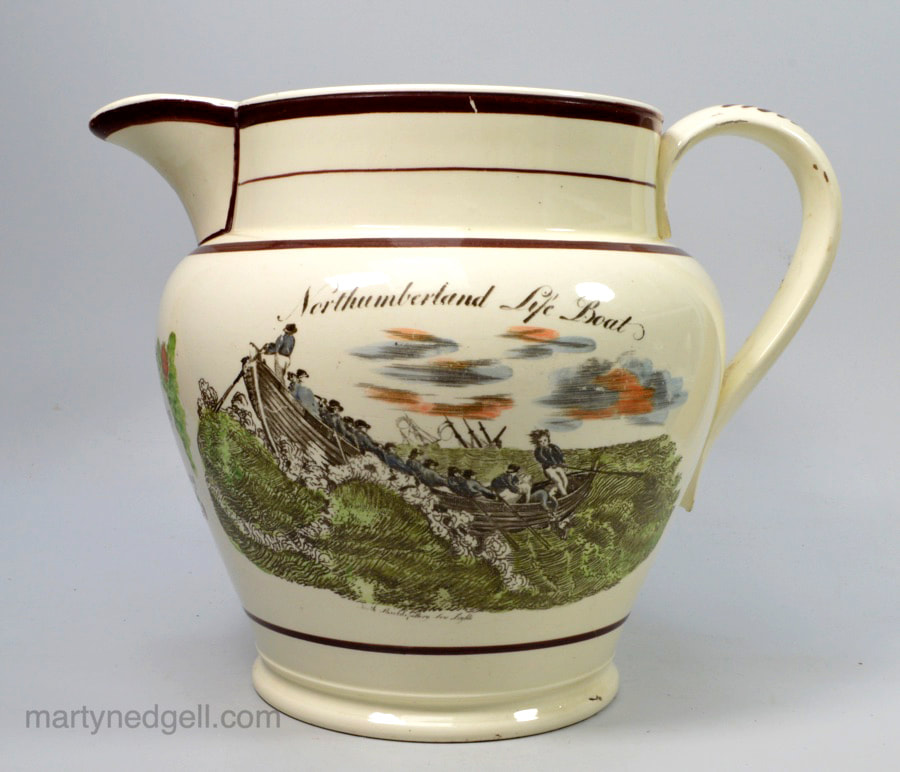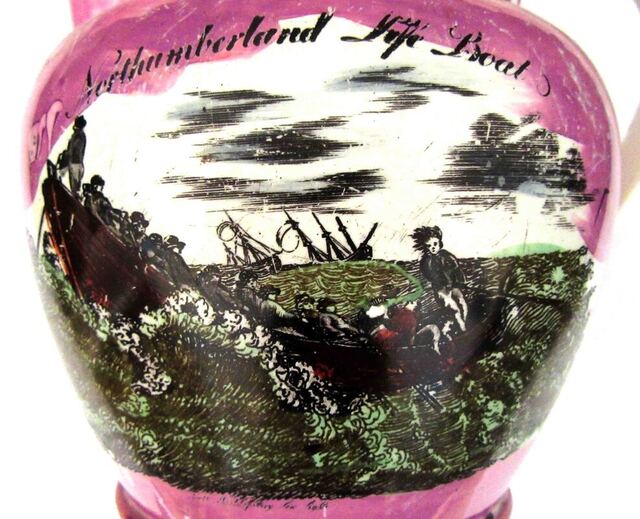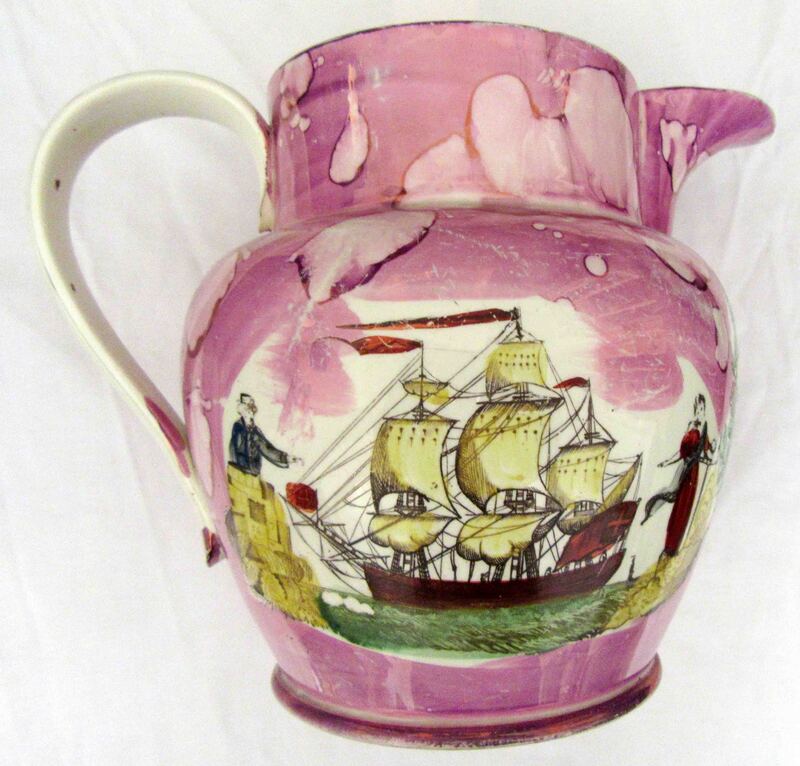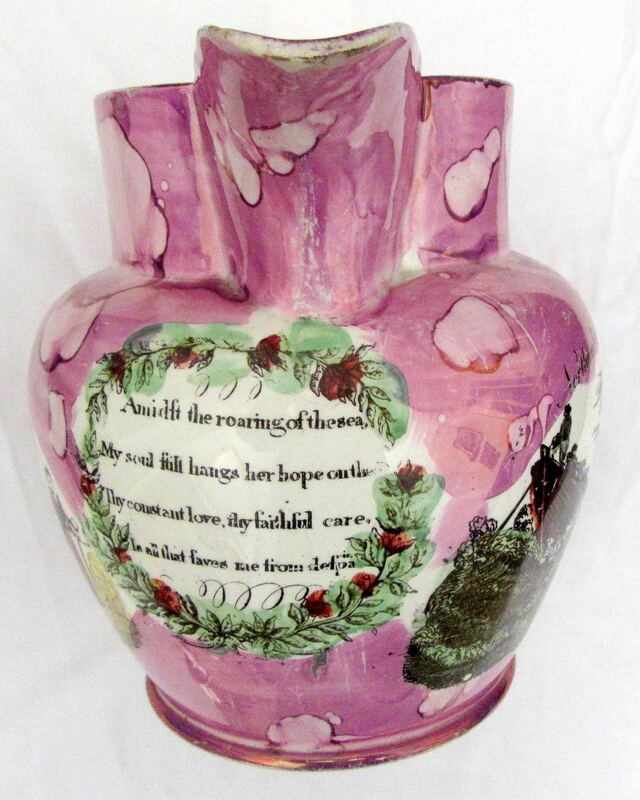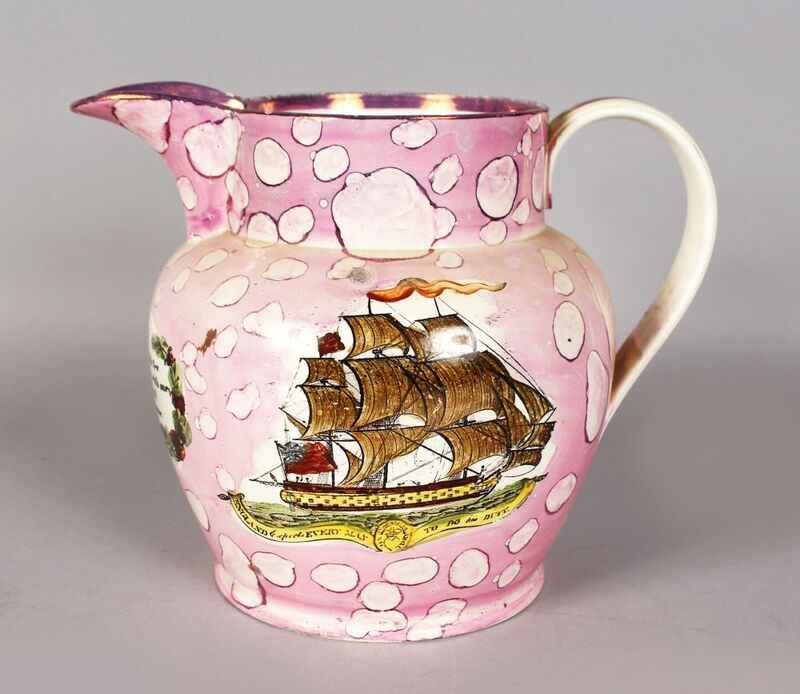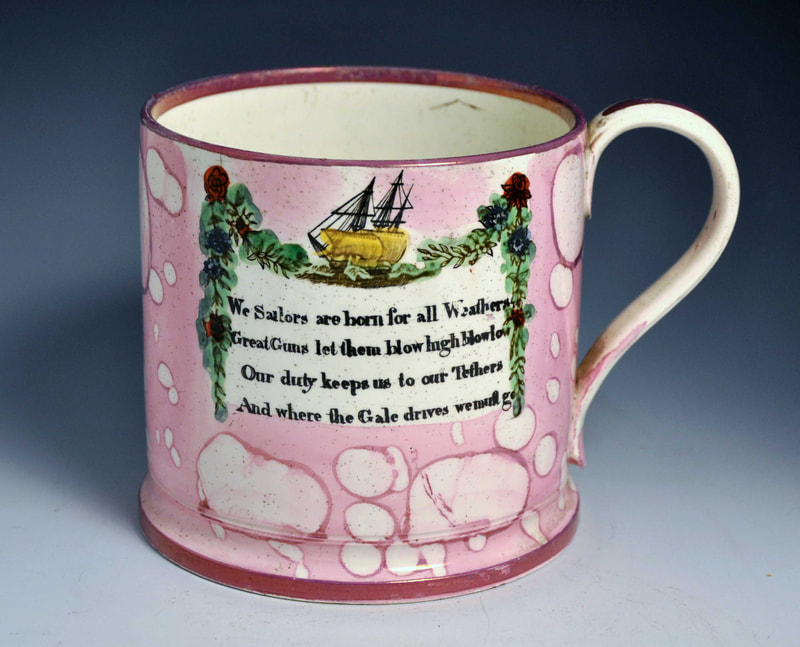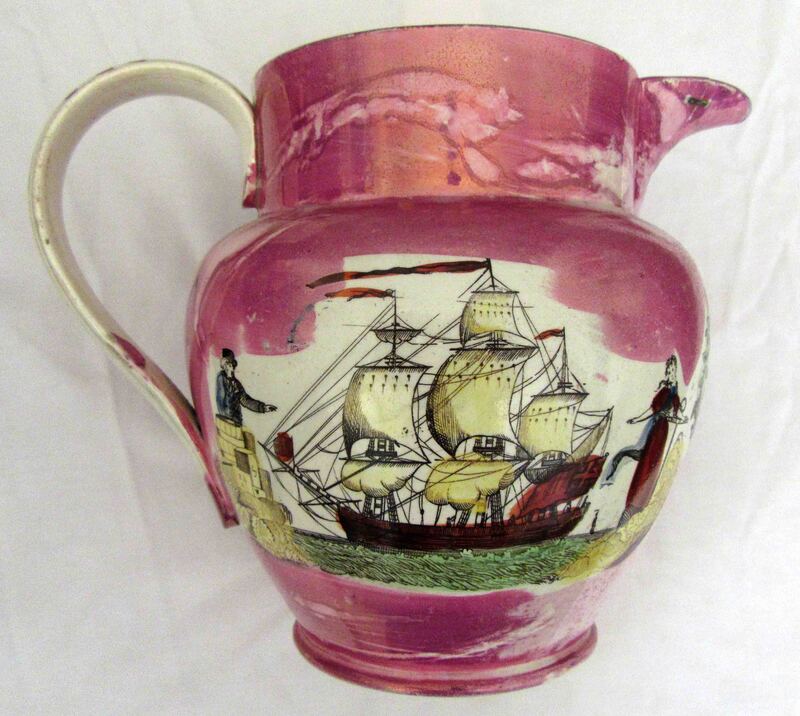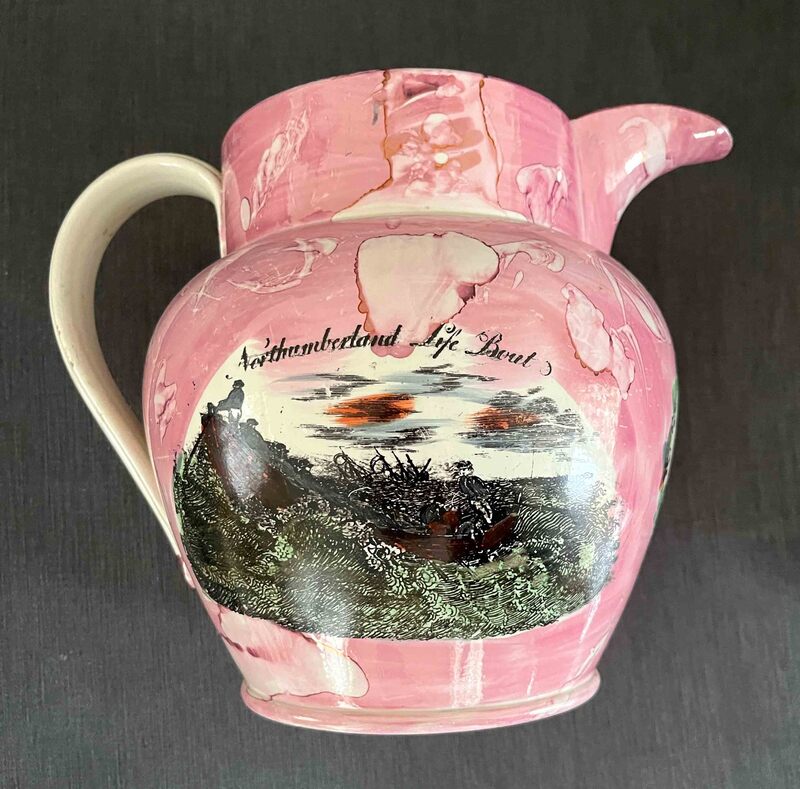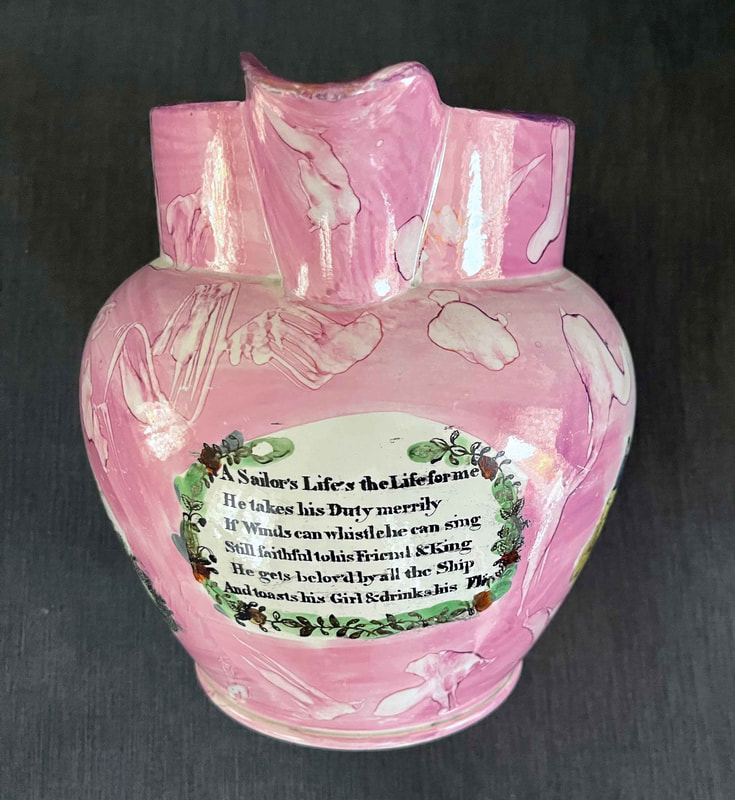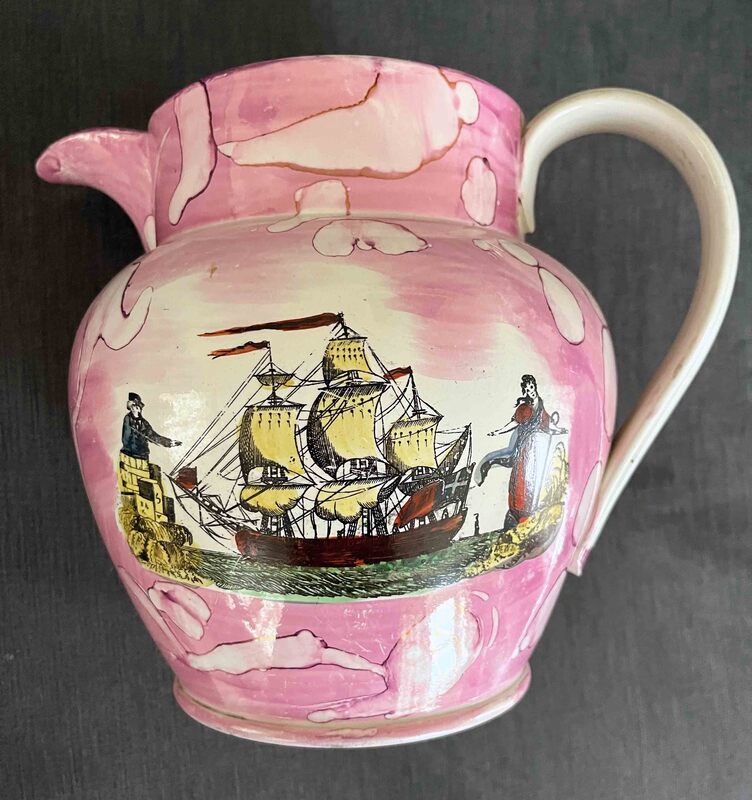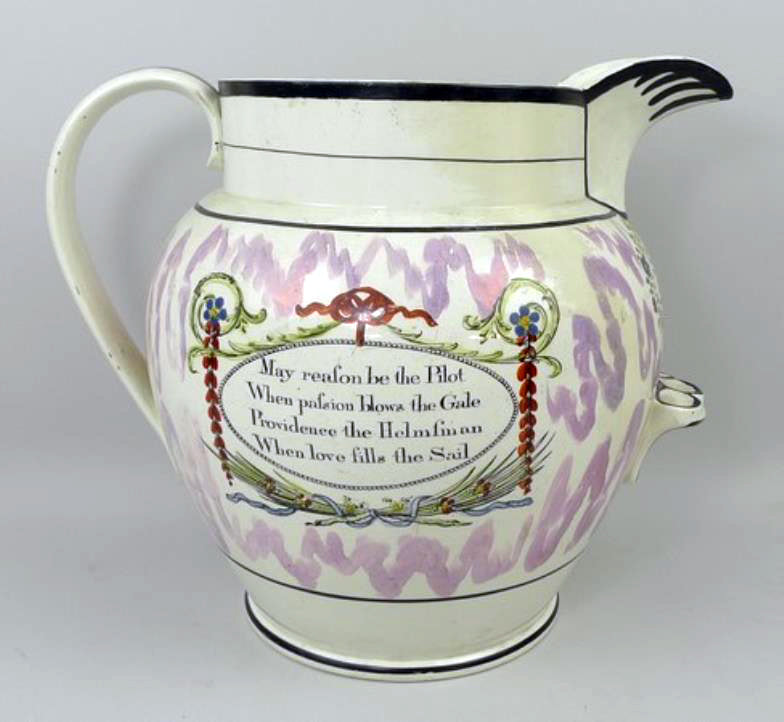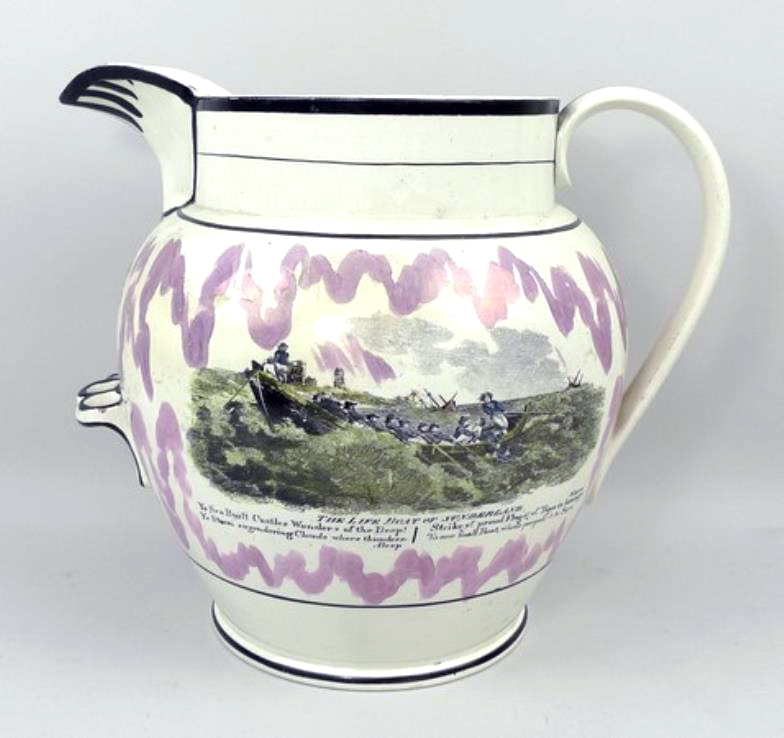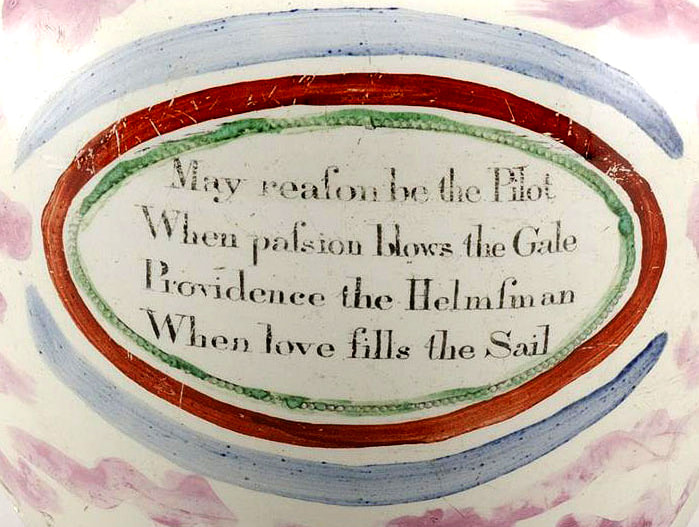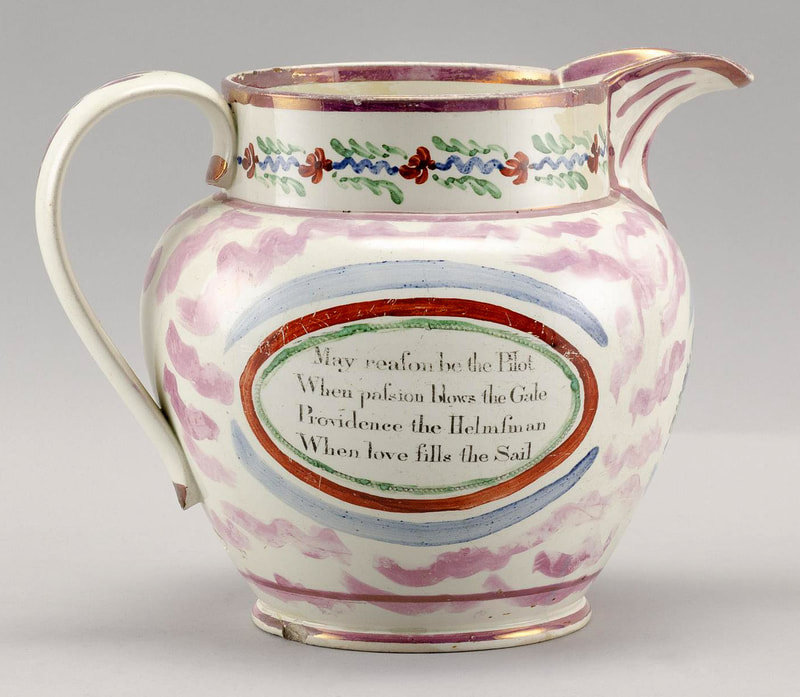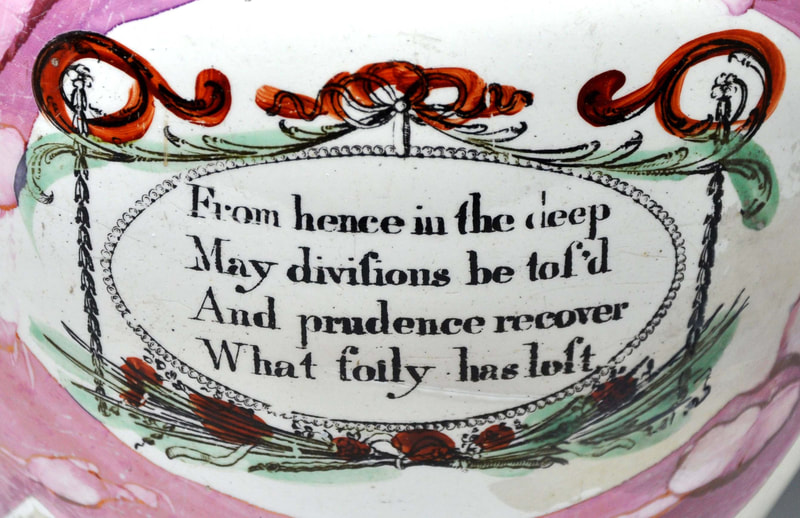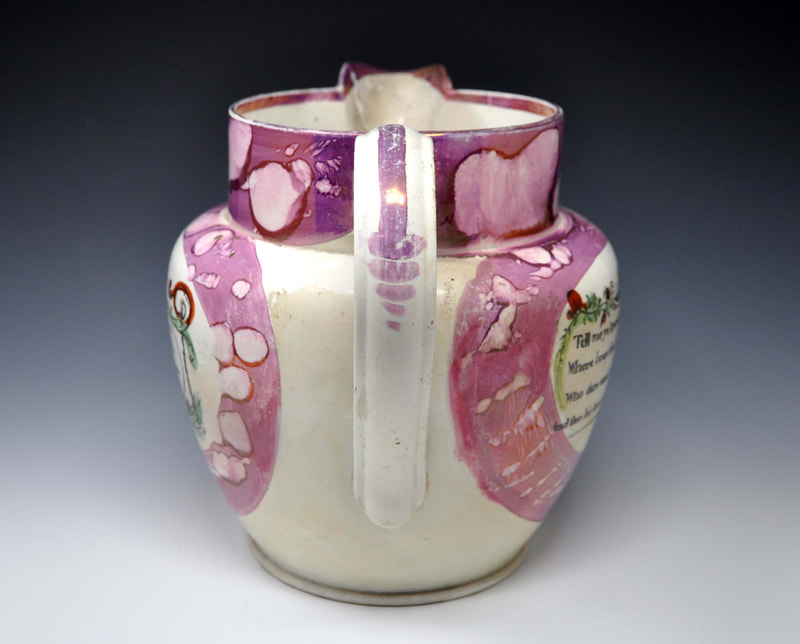Sunderland Life Boat – Sunderland potteries
J Phillips, Sunderland Pottery and Dixon, Austin & Co, Sunderland Pottery
From 1817, the Sunderland Pottery operated on two sites: one at North Hylton and the Garrison Pottery. That makes for a confusing array of printed marks. This jug, however, which has a 'J Phillips North Hylton' mark to the bridge transfer on the reverse, was likely made under the Dixon Austin partnership in the 1830s.
Perhaps more interestingly, the Sunderland Lifeboat transfer has a printed mark 'R. SCOTT' and 'N.B.' Norman Lowe has, I think, decoded this. Thanks to him for the information that follows. The 'NB' likely stands for Newbottle, in the same way that the initials 'NC' appear on Newcastle items. Ralph Scott is recorded as a potter at Newbottle between 1804 and 1810, raising the possibility that somewhere out there, there is a creamware ovoid jug or large tankard from Newbottle with this transfer.
Ralph Scott was christened at Houghton-le-Spring on 10 January 1779 to parents George Scott and Jane Fairbairns. He was a cousin of Anthony Scott (Snr) who managed Byers & Co's pottery at Newbottle, and who with his father Henry (Ralph's uncle) and Edward Atkinson, set up what would become Scott's Pottery in Southwick.
Between 1804 and 1810, Ralph had, with his wife Ann Lowes, 3 children all christened at Houghton. In 1811 his daughter Frances was christened at St Peter’s Monkwearmouth (not far from the Garrison pottery) and in 1819 he is recorded in the Durham County Advertiser as being from Low Ford (not far from Dawson’s). Finally, his death is recorded on 3 November 1825 as being Ralph Scott of Ouseburn Pottery late of Houghton-le-Spring. It seems that on his death, or perhaps even before that, the copper transfer plate was sold on to the Sunderland Pottery which used it without any attempt to remove the printed mark.
The right of the transfer is signed with the engraver's name 'Cockburn', for Walter Cockburn. Walter married Ann Rain Parker on 27 August 1804, and was listed as silversmith and engraver of Bishopwearmouth. By 25 January 1812, when his son John Augustus died of worms, aged 27 months, Walter is listed as 'Engraver' living in High Street, Sunderland (see Nick Dolan, Northern Ceramic Society Journal, volume 9, p60, 1992). The second jug, from the Sunderland Museum & Winter Gardens, Tyne & Wear Archives & Museums collection, is likely earlier, from the 1820s.
Ralph Scott was christened at Houghton-le-Spring on 10 January 1779 to parents George Scott and Jane Fairbairns. He was a cousin of Anthony Scott (Snr) who managed Byers & Co's pottery at Newbottle, and who with his father Henry (Ralph's uncle) and Edward Atkinson, set up what would become Scott's Pottery in Southwick.
Between 1804 and 1810, Ralph had, with his wife Ann Lowes, 3 children all christened at Houghton. In 1811 his daughter Frances was christened at St Peter’s Monkwearmouth (not far from the Garrison pottery) and in 1819 he is recorded in the Durham County Advertiser as being from Low Ford (not far from Dawson’s). Finally, his death is recorded on 3 November 1825 as being Ralph Scott of Ouseburn Pottery late of Houghton-le-Spring. It seems that on his death, or perhaps even before that, the copper transfer plate was sold on to the Sunderland Pottery which used it without any attempt to remove the printed mark.
The right of the transfer is signed with the engraver's name 'Cockburn', for Walter Cockburn. Walter married Ann Rain Parker on 27 August 1804, and was listed as silversmith and engraver of Bishopwearmouth. By 25 January 1812, when his son John Augustus died of worms, aged 27 months, Walter is listed as 'Engraver' living in High Street, Sunderland (see Nick Dolan, Northern Ceramic Society Journal, volume 9, p60, 1992). The second jug, from the Sunderland Museum & Winter Gardens, Tyne & Wear Archives & Museums collection, is likely earlier, from the 1820s.
This cropped version of the subject is like the more familiar Tyneside version below. It is hard to be sure whether this imprint is from the same copper plate as the items above. The lower border is perhaps touched in with black enamel. This jug is again from the 1820s.
Ball's Deptford Pottery – The First Life Boat was Built at South Shields 1789
A different rendering of the subject at Ball's Deptford Pottery, some 50 years or so later. You can read more on Ian Holmes' site. The first slip-moulded jug below is from the Sunderland Museum & Winter Gardens, Tyne & Wear Archives & Museums collection.
The transfers are easier to read on the monochrome jug below.
Both the lifeboat transfer and the portrait of Willie Wouldhave have printed marks beneath them saying 'COPYRIGHT' and 'BALLS BROS SUNDERLAND'.
Life Boat – Tyneside potteries
Robert Maling, Ouseburn Bridge Pottery, 1820s
Wheat-ear decorated jug – group 1
Wheat-ear decorated jug– group 2
Robert Maling, Ouseburn Bridge Pottery, late 1830s
Robert Maling, Ouseburn Bridge Pottery, late 1830s / early 1840s
A small version of the transfer on a slightly later jug.
William and Grace Darling
Robert Maling, Ouseburn Bridge Pottery, after 1838
Robert Maling, Ouseburn Bridge Pottery, after 1838
Robert Maling, Ouseburn Bridge Pottery, after 1838
A smaller version of the transfer for a cream jug.
Northumberland Life Boat
Collingwood & Beall, North Shields Pottery, 1814?–1823
This jug has a printed mark for 'Collingwood & Beall, N Shields'. Usually when these marks appear, they are partially scratched out, and on later, 1830s', pink-lustre items from the C, C & Co partnerships at North Shields. This is the first contender I have seen to be a true c1820 item made by Collingwood & Beall.
Attributed to Bird & Co, Northumberland Pottery, North Shields, 1823–1827
and Low Lights Pottery, North Shields
This intricately decorated jug was likely made by Bird & Co's 'Northumberland Earthenware Manufactory'. The transfer comes from the same copper plate as the item above and the jug is decorated in similar red enamels.
The jug above doesn't have any printed marks. However, during a later round of re-engraving 'North Shields Pottery Low Lights' was added below the transfer (see right imprint below). It was likely added after the pottery changed hands in 1827.
The left transfer, from the first jug below, has no flourish after the word 'Boat' in the title, which appears to have been accidentally trimmed off on this imprint. The right transfer above is from the second jug below.
Attributed to Cornfoot, Colville & Co, North Shields, 1828–1832, or Cornfoot, Carr and Co, North Shields, 1832–1838
This appears to be from the same copper plate as the items above, and again has the printed mark below the transfer 'North Shields Pottery Low Lights'.
The next items have an almost identical transfer, but with no printed mark.
The Life Boat of Sunderland – unknown pottery
Wearside or Tyneside?
Sadly, these are the only photos I have of this transfer. The very large jug below has a handle to aid pouring, and lustre decoration similar to that found on Sunderland Pottery items above. However, I'm not sure if it was made on Tyneside or Wearside. The verses are 'May reason be the Pilot, When passion blows the Gale' and 'The Tear'. If you have an item with 'THE LIFE BOAT OF SUNDERLAND' transfer, I would love to hear from you (see link at bottom of this page).
You can see from various dinks and scratches that the 'Pilot' transfer on the jug below is a trimmed down imprint from the same copper plate as the jug above. I suspect it was trimmed to make this old style of transfer appear more modern. Likewise, 'The Tear' transfer is apparently from the same copper plate with the addition of a small ship and the title 'SAILOR'S DOOM' at the top of the transfer on the jug below. I have previously attributed the jug below to North Shields, but 'The Life Boat of Sunderland' transfer on the jug above makes me less sure.
Below is a firmly attributable North Shields (Cornfoot, Carr & Co from the 1830s) jug with a very similar style of transfer. Ian Holmes has pointed out that the old-fashioned style of these transfers is reminiscent of those used by Warburton. It appears that Warburton auctioned off their copper transfer plates, and both Moore and Scott in Southwick (Sunderland) used transfers with Warburton marks in the 1830s. It is possible that the Life Boat of Sunderland jug was made by Warburton on Tyneside in the 1820s. We need to find other items with these transfers to move the attribution forwards.






